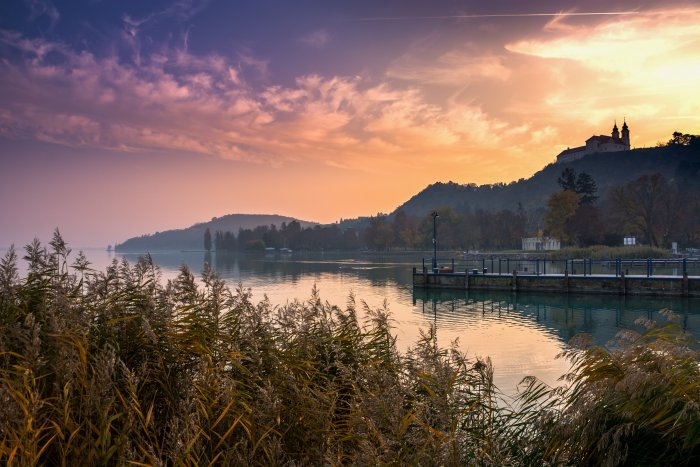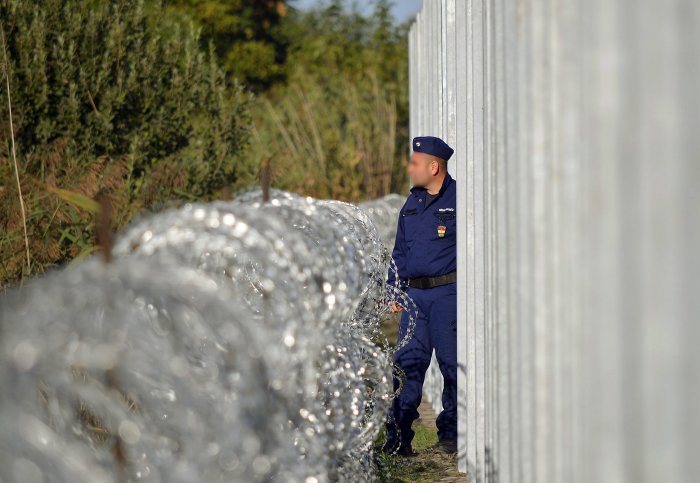At Last, I’m off to see the Hungarian Sea

Image by Ádám Polgár/Shutterstock.com
This will be the summer I finally get to Lake Balaton. It’s a place that intrigues me. In the United Kingdom, we have freshwater lakes. But they’re puddles compared to what is all but an inland sea that Hungarians call simply the Balaton and they’re not central to our sense of ourselves.
Sunset over the picturesque town of Tihany, with is twin-towered abbey, on the northern shore of Lake Balaton. Photo by Ádám Polgár/Shutterstock.com.
There are 231 square miles of Lake Balaton, which runs for 48 miles and is nine miles across at its widest point. It became a place for the wealthy to take vacations in the 19th century. In the 20th century, landowners whose vineyards had been decimated by the phylloxera epidemic that began in Britain and swept across Europe built summer homes and rented them to the growing middle classes.
Large-scale tourism really took off when the southern railway arrived in 1861, followed by the northern line in 1909. By the 1920s, around 50,000 tourists were vacationing at resorts on both shores of the lake. In the summers immediately before World War II, this number had grown to 200,000.
When the war ended, the communist government confiscated the private villas that had belonged to landowners. They also built holiday homes for trade unions, many of which are now private hotels. Under communism, Balaton was one of the few places Hungarians could enjoy a degree of freedom. In the 1960s and 1970s, it became the vacation destination of choice for ordinary Magyars.
Lake Balaton was also popular with other people who lived in the Eastern Bloc. East Germans in particular came in large numbers. The reason wasn’t necessarily the charms of the lake. It was a place where families and friends who had been abruptly separated by the building of the Berlin Wall in 1961 could meet.
This, I’ve been told, is why you still see so many signs proclaiming “Zimmer Frei!” – rooms available – in the area. It’s presumably also why so many Balatonians speak German.
Still They Come
After the Wall came down in 1989 and the Soviet Union collapsed in 1991, there was no burning reason for members of other Eastern Bloc countries to trek to Balaton. But this hasn’t stopped the Germans and Russians from coming to the Hungarian Sea.
In 2013, according to the website We Love Budapest, 72,000 Germans stayed in hotels and the like at Balaton, and 28,000 Russians. I wonder whether this is purely because of the undoubted charms of Balaton, or whether nostalgia also plays its part. The Dutch also come in reasonable numbers, but no-one seems quite sure why.
The number of Hungarians who head for the hotels and other forms of accommodation at Balaton seems to be rising all the time. In the years between 2003 and 2013, again according to welovebalaton.hu, it roughly doubled from 567,614 to a little over a million. In the summer of 2018, 1.5 million alone took Balaton trains.
It’s not surprising, then, that the Hungarian national rail company MÁV has put on more trains to meet summer demand. The journey takes around two hours and, throughout the summer, trains leave from Delí Station in Buda roughly every two hours.
To me, there’s something deeply symbolic about the fact that Hungary looks inward to its sea. But I can also understand why Hungarians might be reluctant to get on planes and schlep to the Mediterranean or wherever. The delights of Balaton are clearly many and various.
Being of a certain age, I’m drawn to the north side of the lake. The southern side is, I’m told, where all the resort towns are, and the water is shallower. I’m curious to observe Hungarians on holiday in their natural habitat. But I don’t want to swim in a vast expanse of tepid bathwater and be forced to listen to night after night of thumping techno. Much as I love lángos (deep fat fried dough) and hekk (the saltwater fish hake) and fries, I’d rather not eat them every day, and I know I’ll succumb.
Going back to symbolism, I can’t help but wonder whether the reason Hungarians love hekk so much is that eating it reminds them of back when they had a proper sea, before the breakup of Austro-Hungary. And the Hungarian love of the sea is a mighty powerful thing. Whether it’s the Mediterranean or the murky North Sea, the ocean sends my Hungarian partner into raptures.
Heading North
No, I’ll be taking the ferry from the south side of Balaton to the Tihany Peninsula on the northern shore. The jewel of the peninsula is baroque Tihany Abbey, pictured here, which, I’m told, has the best view of the lake.
The village of Tihany itself looks positively Mediterranean and utterly beautiful. So it’s not surprising that it’s supposed to have the highest housing prices in Hungary. The 2011 rumor that Brad Pitt and Angelina Jolie were contemplating renting the former summer home of Hapsburg Archduke Joseph on the peninsula helped send asking prices soaring.
No-one, other than Brangelina, can confirm whether the story is true. In any case, I prefer my myths and legends to be more colorful and ancient. I’ll be looking for the “The Shouting Girl” stone. This commemorates a princess with golden-haired goats whose pride caused her to be cursed by the king of the lake. According to legend, her goats vanished into the Balaton and only their nails remained. These have been washed up on the shore ever since.
Apparently, selling “goat nails” to tourists was a profitable business for the children of the area between the wars. What they were hawking was really the triangle-shaped corners of prehistoric clams. A fine example of Hungarian ingenuity, and also gullibility.
My source for much of the factual content of this article was the excellent website welovebalaton.hu. Before you plan your trip to Lake Balaton, I suggest you head to the website first.
SUPPORT THE BUDAPEST BUSINESS JOURNAL
Producing journalism that is worthy of the name is a costly business. For 27 years, the publishers, editors and reporters of the Budapest Business Journal have striven to bring you business news that works, information that you can trust, that is factual, accurate and presented without fear or favor.
Newspaper organizations across the globe have struggled to find a business model that allows them to continue to excel, without compromising their ability to perform. Most recently, some have experimented with the idea of involving their most important stakeholders, their readers.
We would like to offer that same opportunity to our readers. We would like to invite you to help us deliver the quality business journalism you require. Hit our Support the BBJ button and you can choose the how much and how often you send us your contributions.


.png)




.jpg)

.png)
